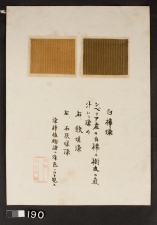Difference between revisions of "Siberia-san Shirakaba - right (190 R)"
Jump to navigation
Jump to search
(username removed) |
(username removed) |
||
| Line 5: | Line 5: | ||
| 190 | | 190 | ||
|- | |- | ||
| − | ! scope="row"| | + | ! scope="row"|Uemura number / title |
| − | | | + | | ; "Haze-some 25" |
|- | |- | ||
! scope="row"|Folder location | ! scope="row"|Folder location | ||
| Line 44: | Line 44: | ||
| - | | - | ||
|- | |- | ||
| − | ! scope="row"| | + | ! scope="row"|Uemura's notes |
| − | | The dyeing technique is found in the "Senryo shokubutsu fu ( | + | | The dyeing technique is found in the "Senryo shokubutsu fu ()", published in 1972, Japan. The plant material came from Siberia. |
|- | |- | ||
| − | ! scope="row"| | + | ! scope="row"|Uemura's date |
| Kyoto | | Kyoto | ||
|} | |} | ||
| − | [[Category: | + | [[Category:Uemura dye archive]] |
Latest revision as of 06:18, 24 July 2013
| Museum number | 190 |
|---|---|
| Uemura number / title | ; "Haze-some 25" |
| Folder location | 3rd shelf |
| Sample location | right (190 R) |
| Fiber type | silk |
| Color | dark brown |
| Dyestuff (Japanese common name) | シベリア産 白樺 : Siberia-san Shirakaba |
| Dye (English common name) | Birch from Siberia |
| Dyestuff (botanical name) | Betula platyphylla Sukaczev var. japonica (Miq.) H.Hara |
| Plant part | bark /dried (?) |
| Dyestuff extraction | boiled in water |
| Auxiliary agent in dye bath | - |
| Mordant | iron |
| Other auxiliary agent | - |
| Uemura's notes | The dyeing technique is found in the "Senryo shokubutsu fu ()", published in 1972, Japan. The plant material came from Siberia. |
| Uemura's date | Kyoto |
